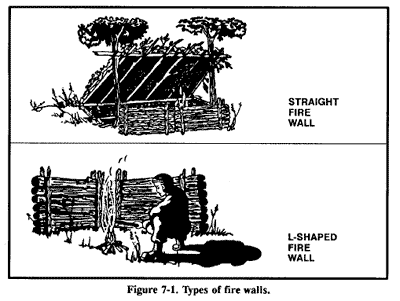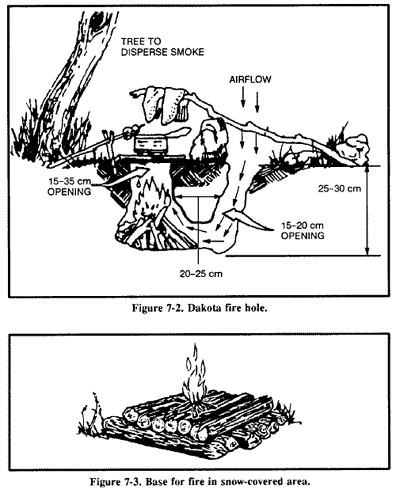Firecraft - Site Selection and Preparation
You will have to decide what site and arrangement to use. Before building a fire consideró
- The area (terrain and climate) in which you are operating.
- The materials and tools available.
- Time: how much time you have?
- Need: why you need a fire?
- Security: how close is the enemy?
Look for a dry spot tható
- Is protected from the wind.
- Is suitably placed in relation to your shelter (if any).
- Will concentrate the heat in the direction you desire.
- Has a supply of wood or other fuel available. (See page 7-6 for types of material you can use.)
If you are in a wooded or brush-covered area, clear the brush and scrape the surface soil from the spot you have selected. Clear a circle at least 1 meter in diameter so there is little chance of the fire spreading.
If time allows, construct a fire wall using logs or rocks. This wall will help to reflector direct the heat where you want it (Figure 7-l). It will also reduce flying sparks and cut down on the amount of wind blowing into the fire. However, you will need enough wind to keep the fire burning.
CAUTION
Do not use wet or porous rocks as they may explode when heated.
In some situations, you may find that an underground fireplace will best meet your needs. It conceals the fire and serves well for cooking food. To make an underground fireplace or Dakota fire hole (Figure 7-2)Ė
- Dig a hole in the ground.
- On the upwind side of this hole, poke or dig a large connecting hole for ventilation.
- Build your fire in the hole as illustrated.

If you are in a snow-covered area, use green logs to make a dry base for your fire (Figure 7-3). Trees with wrist sized trunks are easily broken in extreme cold. Cut or break several green logs and lay them side by side
on top of the snow. Add one or two more layers. Lay the top layer of logs opposite those below it.


Survival Skills
Survival Actions
Psyhology of Survival
Survival Planning and Survival Kits
Survival Medicine
Survival Medicine - Requirements for Maintenance of Health
Survival Medicine - Medical Emergencies
Survival Medicine - Lifesavings Steps
Survival Medicine - Bone And Joint Injury
Survival Medicine - Bites and Stings
Survival Medicine - Wounds
Survival Medicine - Environmental Injuries
Survival Medicine - Herbal Medicines
Shelters
Shelters - Shelter Site Selection
Shelters - Types of Shelters
Water Procurement - Water Sources
Water Procurement - Still Construction
Water Procurement - Water Purification
Firecraft - Basic Fire Principles
Firecraft - Site Selection and Preparation
Firecraft - Fire Material Selection
Firecraft - How to Build a Fire
Firecraft - How to Light a Fire
Food Procurement - Animals for Food
Food Procurement - Traps and Snares
Food Procurement - Killing Devices
Food Procurement - Fishing Devices
Food Procurement - Preparation of Fish and Game for Cooking and Storage
Survival Use of Plants - Edibility of Plants
Survival Use of Plants - Plants for Medicine
Poisonous Plants
Dangerous Animals - Insects and Arachnids
Dangerous Animals - Poisonous Snakes
Dangerous Animals - Dangerous Lizards
Dangerous Animals - Saltwater Dangers
Field-expedient Weapons, Tools, and Equipment
Field-expedient Weapons - Lashing and Cordage
Field-expedient Weapons - Rucksack Construction
Field-expedient Weapons - Clothing and Insulation
Field-expedient Weapons - Cooking and Eating
Desert Survival - Terrain
Desert Survival - Environmental Factors
Desert Survival - Need For Water
Desert Survival - Heat Casualties
Desert Survival - Precautions and Desert Hazards
Tropical Survival - Tropical Weather
Tropical Survival - Jungle Types
Tropical Survival - Travel Through Jungle Areas
Tropical Survival - Immediate Considerations
Tropical Survival - Water Procurement
Tropical Survival - Food
Cold Weather Survival - Cold Regions And Locations
Cold Weather Survival - Basic Principles Of Cold Weather Survival
Cold Weather Survival - Hygiene and Medical Aspects
Cold Weather Survival - Cold Injuries
Cold Weather Survival - Shelters
Cold Weather Survival - Fire
Cold Weather Survival - Water
Cold Weather Survival - Food
Cold Weather Survival - Travel
Cold Weather Survival - Weather Signs
Sea Survival - The Open Sea
Sea Survival - Seashores
Expedient Water Crossings - Rivers and Streams
Expedient Water Crossings - Rapids
Expedient Water Crossings - Rafts
Expedient Water Crossings - Flotation Devices
Expedient Water Crossings - Other Water Obstacles
Field-expedient Direction Finding - Using the Sun and Shadows
Field-expedient Direction Finding - Using the Moon and the Stars
Field-expedient Direction Finding - Making Improvised Compasses
Field-expedient Direction Finding - Other Means of Determining Direction
Signaling Techniques
Signaling Techniques - Means For Signaling
Signaling Techniques - Codes and Signals
Signaling Techniques - Aircraft Vectoring Procedures
Survival Movement in Hostile Areas - Phases of Planning
Survival Movement in Hostile Areas - Execution
Survival Movement in Hostile Areas - Return to Friendly Control
Camouflage - Personal Camouflage
Camouflage - Methods Of Stalking
Contact With People
Contact With People - The Survivorís Behavior
Survival In Man-made Hazards - The Nuclear Environment
Survival In Man-made Hazards - Biological Environments
Survival In Man-made Hazards - Chemical Environments
Survival Actions
Psyhology of Survival
Survival Planning and Survival Kits
Survival Medicine
Survival Medicine - Requirements for Maintenance of Health
Survival Medicine - Medical Emergencies
Survival Medicine - Lifesavings Steps
Survival Medicine - Bone And Joint Injury
Survival Medicine - Bites and Stings
Survival Medicine - Wounds
Survival Medicine - Environmental Injuries
Survival Medicine - Herbal Medicines
Shelters
Shelters - Shelter Site Selection
Shelters - Types of Shelters
Water Procurement - Water Sources
Water Procurement - Still Construction
Water Procurement - Water Purification
Firecraft - Basic Fire Principles
Firecraft - Site Selection and Preparation
Firecraft - Fire Material Selection
Firecraft - How to Build a Fire
Firecraft - How to Light a Fire
Food Procurement - Animals for Food
Food Procurement - Traps and Snares
Food Procurement - Killing Devices
Food Procurement - Fishing Devices
Food Procurement - Preparation of Fish and Game for Cooking and Storage
Survival Use of Plants - Edibility of Plants
Survival Use of Plants - Plants for Medicine
Poisonous Plants
Dangerous Animals - Insects and Arachnids
Dangerous Animals - Poisonous Snakes
Dangerous Animals - Dangerous Lizards
Dangerous Animals - Saltwater Dangers
Field-expedient Weapons, Tools, and Equipment
Field-expedient Weapons - Lashing and Cordage
Field-expedient Weapons - Rucksack Construction
Field-expedient Weapons - Clothing and Insulation
Field-expedient Weapons - Cooking and Eating
Desert Survival - Terrain
Desert Survival - Environmental Factors
Desert Survival - Need For Water
Desert Survival - Heat Casualties
Desert Survival - Precautions and Desert Hazards
Tropical Survival - Tropical Weather
Tropical Survival - Jungle Types
Tropical Survival - Travel Through Jungle Areas
Tropical Survival - Immediate Considerations
Tropical Survival - Water Procurement
Tropical Survival - Food
Cold Weather Survival - Cold Regions And Locations
Cold Weather Survival - Basic Principles Of Cold Weather Survival
Cold Weather Survival - Hygiene and Medical Aspects
Cold Weather Survival - Cold Injuries
Cold Weather Survival - Shelters
Cold Weather Survival - Fire
Cold Weather Survival - Water
Cold Weather Survival - Food
Cold Weather Survival - Travel
Cold Weather Survival - Weather Signs
Sea Survival - The Open Sea
Sea Survival - Seashores
Expedient Water Crossings - Rivers and Streams
Expedient Water Crossings - Rapids
Expedient Water Crossings - Rafts
Expedient Water Crossings - Flotation Devices
Expedient Water Crossings - Other Water Obstacles
Field-expedient Direction Finding - Using the Sun and Shadows
Field-expedient Direction Finding - Using the Moon and the Stars
Field-expedient Direction Finding - Making Improvised Compasses
Field-expedient Direction Finding - Other Means of Determining Direction
Signaling Techniques
Signaling Techniques - Means For Signaling
Signaling Techniques - Codes and Signals
Signaling Techniques - Aircraft Vectoring Procedures
Survival Movement in Hostile Areas - Phases of Planning
Survival Movement in Hostile Areas - Execution
Survival Movement in Hostile Areas - Return to Friendly Control
Camouflage - Personal Camouflage
Camouflage - Methods Of Stalking
Contact With People
Contact With People - The Survivorís Behavior
Survival In Man-made Hazards - The Nuclear Environment
Survival In Man-made Hazards - Biological Environments
Survival In Man-made Hazards - Chemical Environments